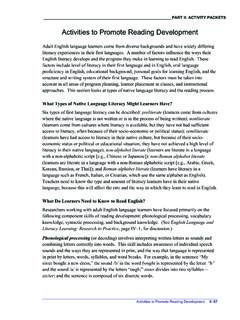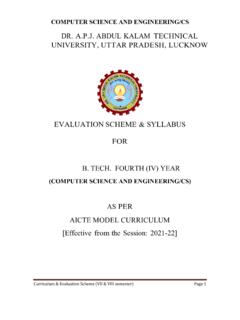Transcription of © opyright 2017, International Dyslexia Association (IDA).
1 Introduction 2 About IDA 2 What is Dyslexia ? 3 Signs and Symptoms of Dyslexia 4 Social and Emotional Connection 5 Classroom Strategies, Tips, and Tools 7 Multisensory Structured Language Teaching 11 Screening, Evaluation, and Diagnosis 12 Additional Resources and Further Reading 14 References 15 Copyright 2017, International Dyslexia Association (IDA). IDA encourages the reproduction and distribution of this resource kit. If portions of the text are cited, appropriate reference must be made. This may not be reprinted for the purpose of resale. 40 York Road, 4th Floor Baltimore, MD 21204 TABLE OF CONTENTS 1 The degree of difficulty a child with Dyslexia has with reading, spelling, and/or speaking varies from person to person due to inherited differences in brain development, as well as the type of teaching the person receives.
2 The brain is normal, often very intelligent, but with strengths in areas other than the language area. This difference goes undetected until the person finds difficulty when learning to read and write. Each individual with Dyslexia is unique, but the multisensory approach is flexible enough to serve a wide range of ages and learning differences. A multisensory approach can be valuable to many; to the dyslexic child it is essential. The expertise of the teacher is the key. The intent of this toolkit is to provide classroom teachers with basic information about Dyslexia , dispel some of the myths and misconception surrounding it and be a resource that will increase their capacity to ensure the success of the diverse group of learners in their classrooms.
3 INTRODUCTION The International Dyslexia Association (IDA) was founded in 1949 as The Orton Society to honor and further the work and passion of Dr. Samuel Torrey Orton. IDA serves individuals with Dyslexia , their families, and professionals in the field. We have more than 9,000 members, 42 branches throughout the United States and Canada and have 27 global partners in 23 countries. Together we are working to help those with and affected by Dyslexia . We believe that all individuals have the right to achieve their potential, that individual learning abilities can be strengthened, and that social, educational and barriers to language acquisition and use must be removed.
4 IDA actively promotes effective teaching approaches and related clinical educational intervention strategies for individuals with Dyslexia . We support and encourage interdisciplinary research. We facilitate the exploration of the causes and early identification of Dyslexia and are committed to the responsible and wide dissemination of research and evidence based knowledge. The purpose of IDA is to pursue and provide the most comprehensive range of information and services that address the full scope of Dyslexia and related difficulties in learning to read and a way that creates hope, possibility, and partnership, so that every individual has the opportunity to lead a productive and fulfilling life, and society benefits from the resource that is liberated.
5 ABOUT IDA 2 The formal definition of Dyslexia is: Dyslexia is a specific learning disability that is neurological in origin. It is characterized by difficulties with accurate and/or fluent word recognition and by poor spelling and decoding abilities. These difficulties typically result from a deficit in the phonological component of language that is often unexpected in relation to other cognitive abilities and the provision of effective classroom instruction. Secondary consequences may include problems in reading comprehension and reduced reading experience that can impede the growth of vocabulary and background knowledge.
6 But what does that mean exactly? Dyslexia is a language-based learning disability. Dyslexia refers to a cluster of symptoms, which result in people having difficulties with specific language skills, particularly reading. Students with Dyslexia usually experience difficulties with other language skills, such as spelling, writing, and pronouncing words. Dyslexia affects individuals throughout their lives; however, its impact can change at different stages in a person s life. It is referred to as a learning disability because Dyslexia can make it very difficult for a student to succeed academically in the typical instructional environment, and in its more severe forms, will qualify a student for special education, special accommodations, and/or extra support services.
7 What causes Dyslexia ? The exact causes of Dyslexia are still not completely clear, but anatomical and brain imagery studies show differences in the way the brain of a person with Dyslexia develops and functions. Moreover, most people with Dyslexia have been found to have problems with identifying the separate speech sounds within a word and/or learning how letters represent those sounds, a key factor in their reading difficulties. Dyslexia is not due to either lack of intelligence or desire to learn; with appropriate teaching methods, students with Dyslexia can learn successfully. Dyslexia occurs in people of all backgrounds and intellectual levels.
8 People with Dyslexia can be very bright. They are often capable or even gifted in areas such as art, computer science, design, drama, electronics, math, mechanics, music, physics, sales, and sports. In addition, Dyslexia runs in families; having a parent or sibling with Dyslexia increases the probability that you will also have Dyslexia . For some people, their Dyslexia is identified early in their lives, but for others, their Dyslexia goes unidentified until they get older. What are the effects of Dyslexia ? The impact that Dyslexia has is different for each person and depends on the severity of the condition and the timeliness and effectiveness of instruction or remediation.
9 The core difficulty involves word recognition and reading fluency, spelling, and writing. Some individuals with Dyslexia manage to learn early reading and spelling tasks, especially with excellent instruction, but later experience their most debilitating problems when more complex language skills are required, such as grammar, understanding textbook material, and writing essays. People with Dyslexia can also have problems with spoken language, even after they have been exposed to excellent language models in their homes and high quality language instruction in school. They may find it difficult to express WHAT IS Dyslexia ?
10 3 themselves clearly, or to fully comprehend what others mean when they speak. Such language problems are often difficult to recognize, but they can lead to major problems in school, in the workplace, and in relating to other people. The effects of Dyslexia reach well beyond the classroom. What misconceptions exist regarding Dyslexia ? It is equally important to understand what Dyslexia isn t. There are great misconceptions and myths about Dyslexia which make it that much more difficult for someone with Dyslexia to receive help and generally be understood. It is a myth that individuals with Dyslexia read backwards.



